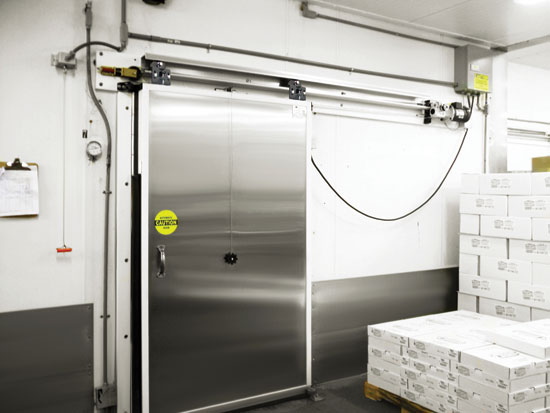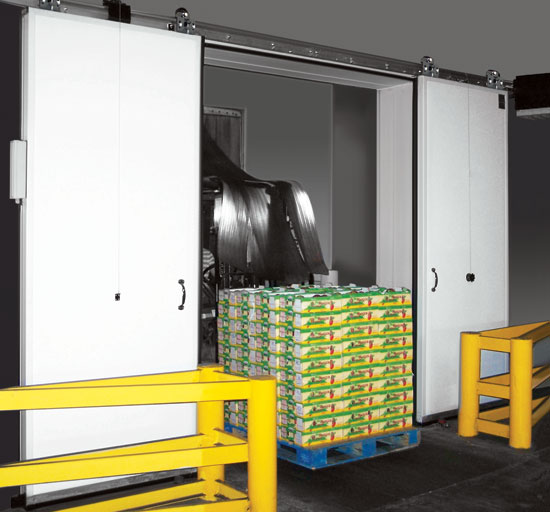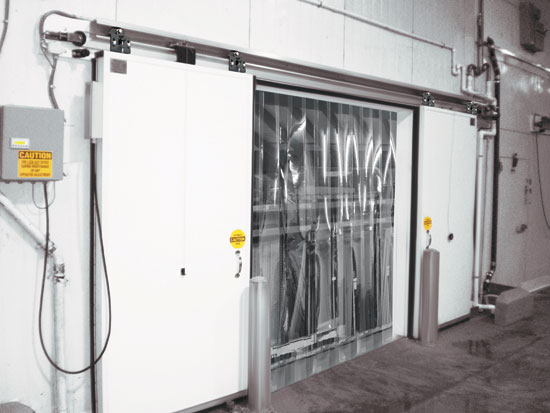Cold Storage Door Systems
While swinging doors in general are commonly used for many building applications, it is the details of these cold storage swinging doors that make them different. This is particularly true when it comes to the air and temperature sealing the perimeter of the door. The type of gasket used in particular is extremely important not only to comply with EISA regulations but to minimize the energy loss overall. Magnetic gaskets with a push in flexibility are one option that provides superior positive sealing since they can accommodate “out of square” or irregular conditions more readily than traditional compression gaskets. Similarly, a sweep sill gasket will prevent thermal infiltration along the bottom of the door. In cases where the door frame is installed flush with the floor line, there can be no need to embed a sill in a concrete floor. Further, if cam lift hinges are used that raise the door when opened, it provides reduced friction on the floor seal and eliminates the need for sloped floors.
In addition to these details there are some other things to be aware of that are options for a swinging cold storage door. First is the use of electric heating in the door or the sill to prevent the build-up of condensation or ice around the perimeter of the door. Such heating needs to be very low wattage and be regulated so that it uses just enough energy to be useful but no more than is needed. If a window is included in the door as an option, there may also be a need to provide some electrification there to prevent condensation or moisture buildup. In regards to hardware, there are choices in types of hinges depending on the size and operation of the door to consider. There are also options on the release latch including some that can be released from the inside even if the door is padlocked on the outside. And of course there are options for finishes. Most doors are finished with metal to comply with sanitation requirements as well as provide a solid measure of durability. These include stainless steel, aluminum, or galvanized steel in a textured or smooth finish.
Sliding Doors
The common alternative to swinging doors is the use of single or double sliding doors that hang on a track in front of the cold storage enclosure. Horizontal sliding doors are best suited for high-use and heavy-duty applications particularly where forklifts and other equipment are used. They are usually designed for high cycle, abusive applications and are considered a true “workhorse” door. From a design standpoint, the horizontal sliding function of the door means that a door swing area does not need to be factored in. However the external wall area adjacent to the door opening obviously needs to be kept clear so that the door can operate properly—it does not recess into the wall since that would compromise the thermal performance of the enclosure. A single sliding door would need to have the wall clearance the full width of the door on the side that it slides toward. If bi-parting doors are selected, then half the width of the door needs to be kept clear on each side of the opening.
In terms of sealing sliding doors when closed, most major cold storage door manufacturers utilize a balloon type seal that is either attached to the jamb casing or the door panel. When the door slides over it, it simply compresses against this seal to restrict air exchange, but doing so makes this type of seal is subject to wear and tear during normal operation and is easily damaged. An innovative seal used by at least one manufacturer utilizes a two-ply, fabric reinforced blade seal against the top and side edges of the door panel. This solves a number of issues including frequent replacement of worn out seals, wear and tear on sealing surfaces and gasket damage from impact. It also minimizes air infiltration and moisture problems common to traditional cold storage doors.
The track that the sliding door hangs on is obviously an important component that can make a difference in the long-term proper operation of the door. Standard duty tracks are typically designed for smaller to midsize doors (6 feet wide or less) while heavy duty tracks are intended for larger doors or those in an abusive environment. Rather than keeping the track and roller system exposed, an optional protective hood system is available from manufacturers. The roller assembly sits on the track allowing for the smooth motion of the door and is available with an anti-lift device to retain its adjustment even when the door is bumped, eliminating the need for secondary adjustments. There is also the option of an adjustable track mounted hold close bracket which prevents “bounce back” on manually operated doors. The combination of the track/roller assembly plus the gasket system impacts the detailed operation of the door. The traditional operation relies on a “down and in” closing motion that pulls the door panel down and in towards the gasket when closed. While this ensures a positive seal, it can make the door difficult to open. Alternatives that use a different gasket system that is coordinated with a properly designed and selected track system can eliminate the need for the down and in motion, making the door easier to operate.

Photo courtesy of Chase Doors
Single sliding doors are mounted on the outside of the enclosure and move to one side of the wall as designed.
To complement the assembly at the top of the door, some cold storage doors incorporate an adjustable floor guide system that installs under the door panel. This concealed design is an alternative to exposed floor rollers that many cold storage doors require. The under panel guide is easy to install, can be adjusted for a perfect seal, and has a much cleaner look than bulky rollers that are prone to being hit by loads passing through the opening.
Like swinging doors, the perimeters swinging doors are typically heated to prevent condensation and ice buildup and other options such as windows and finish materials are available consistent with those for swinging doors. There is even the possibility of adding a smaller, swinging personnel door within the larger sliding door for cases where people walking are using the door as often as larger equipment thus minimizing the door opening impact on cooling. The biggest option in sliding doors, however is whether to use manual or electric operation. In lower use areas, the process of a forklift operator stopping, getting off the forklift and manually opening the door, driving through, stopping, and then closing the door all may be acceptable. But it is clearly not efficient and is prone to having the door open longer than it needs to be. A much smoother operation is to use an electric door opener with an automatic sensor that allows the forklift to approach the door causing it to open for clear passage and then closing behind the forklift once it is inside. The workflow is not interrupted in this way and more goods can be moved in and out of the cold storage area as a result. In order to minimize the opening and closing time, bi-fold doors can be used which will move both panels in half the time it takes for one larger single panel to move. Hence it is common to find single slide doors opening at 18 inches per second and bi-fold doors at 36 inches per second. The electric motor size and type and the associated controls and wiring that go along with it can vary by installation and by the specific manufactured product selected.


Photos courtesy of Chase Doors
In high-activity areas where forklifts are used, bi-parting, electrically operated sliding doors may be the most efficient option.









